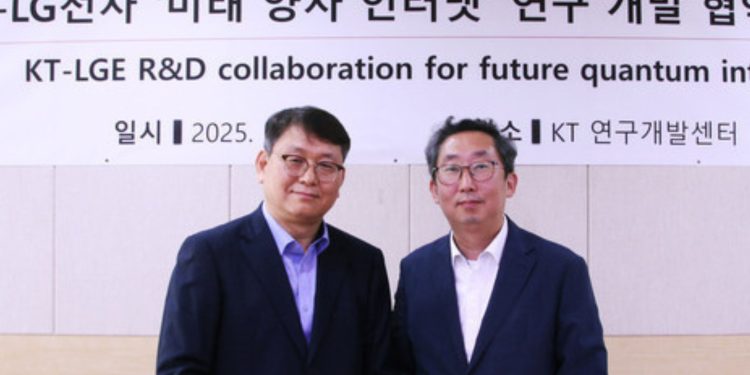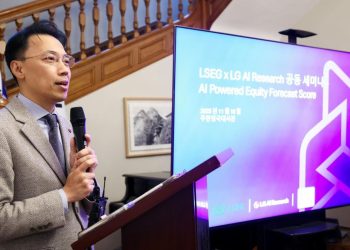A strategic partnership to advance next-generation data security and reinforce Korea’s leadership in quantum networks
LG Electronics and KT Corporation have signed a memorandum of understanding (MOU) to jointly research and develop quantum direct communication (QDC) technology — a cutting-edge data security method designed to detect and prevent eavesdropping in real time.
This collaboration marks a major move by two of South Korea’s most influential technology companies to establish ultra-secure communication systems. The initiative comes as industries worldwide face increasing cybersecurity challenges driven by the rapid adoption of artificial intelligence (AI), autonomous systems, and digital transformation.
“This partnership will help us lay the groundwork for ultra-secure networks that can meet the evolving demands of the AI era,” said an LG Electronics spokesperson. “We see quantum communication as a core enabler of the next generation of trustworthy digital infrastructure.”
The Science Behind Quantum Direct Communication
Quantum direct communication enables data transmission using quantum information units (qubits) — particles that can exist in multiple states simultaneously. Unlike traditional encryption methods, QDC does not rely solely on mathematical algorithms but on the laws of quantum mechanics.
When information is transmitted in a quantum state, any attempt to intercept or monitor the data disrupts the quantum particles, causing the transmission to collapse. This instantly reveals and prevents unauthorized access, making QDC one of the most secure communication methods known today.
In practical terms, QDC could be applied to safeguard communication in:
- Smart factories and industrial IoT systems,
- Connected homes and consumer devices,
- Autonomous vehicles, and
- AI-powered networks that require rapid, secure data transfer.
Building the Foundation for Quantum Internet
Under the MOU, LG Electronics and KT will focus on developing the core infrastructure for quantum internet, including:
- Quantum repeaters that enable long-distance transmission by maintaining quantum signal stability,
- Network element technologies essential for integration into existing systems, and
- Verification and demonstration platforms to test real-world applications.
The companies will also collaborate on standardization efforts, both in South Korea and internationally, to establish global frameworks for quantum-safe communication networks.
A KT official noted, “Quantum technology is the next leap forward in cybersecurity. By combining KT’s network expertise with LG’s quantum research, we aim to lead the commercialization and standardization of quantum internet technologies.”
Extending Partnership from 6G to Quantum Networks
This latest collaboration builds on the ongoing 6G research and development partnership between LG and KT, launched in 2023. Their joint efforts in 6G laid the foundation for high-speed, low-latency connectivity — now serving as a stepping stone toward quantum-enhanced networks.
Both companies view QDC as a natural extension of Korea’s telecom innovation roadmap. By integrating QDC into next-generation network architectures, LG and KT aim to position South Korea as a pioneer in quantum communication and secure networking technologies.
Combining Strengths: Research, Validation, and Commercialization
Each company brings complementary strengths to the partnership:
- LG Electronics has deep expertise in telecommunication systems and quantum science research, with internationally recognized publications and R&D achievements in speed and security optimization.
- KT Corporation contributes proven experience in quantum key distribution (QKD) — another vital technology for secure data exchange — and will lead efforts in system development and field validation to ensure technical reliability.
Together, they will develop and test the core system and network framework for quantum communication, ensuring that it can be scaled for industrial and commercial use.
Positioning Korea as a Global Quantum Leader
This partnership reflects South Korea’s broader ambition to become a leader in global data security innovation. By integrating QDC into next-generation communication systems, LG and KT aim to strengthen Korea’s technological sovereignty and export competitiveness in the emerging quantum internet industry.
“We are entering an era where communication security will define the competitiveness of nations,” an LG Electronics executive said. “Through this collaboration, we intend to lead the global transition toward quantum-secure networks.”
The long-term vision extends beyond domestic deployment. Both companies plan to commercialize quantum communication infrastructure, expand global partnerships, and help shape the international standards that will guide the next evolution of secure digital connectivity.
Analysis: Why This Matters
The LG–KT collaboration comes at a time when cybersecurity threats are escalating alongside the growth of AI-driven ecosystems and data-intensive applications. Traditional encryption methods, while still effective, are increasingly vulnerable to emerging technologies such as quantum computing — which could one day crack classical encryption algorithms.
Quantum communication technologies like QDC offer a future-proof solution, providing built-in security based on the immutable laws of physics rather than mathematical complexity. By investing early in this field, Korea is positioning itself as a global frontrunner in quantum-secure telecommunications — a move that could have far-reaching implications for national security, digital trade, and industrial competitiveness.
✅ Key Takeaways:
- LG Electronics and KT have partnered to develop quantum direct communication (QDC) for ultra-secure data transmission.
- The project builds on their previous collaboration in 6G research, extending into quantum internet infrastructure.
- The partnership aims to commercialize and standardize quantum-secure networks domestically and globally.
- This move reinforces South Korea’s strategic focus on leading next-generation communication and cybersecurity technologies.







